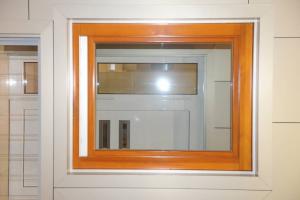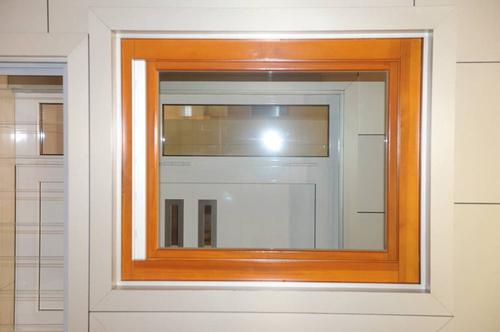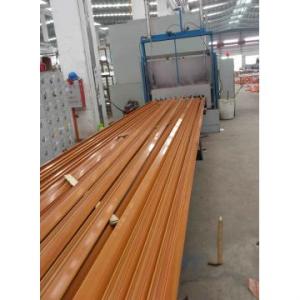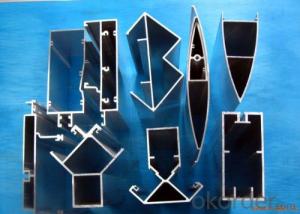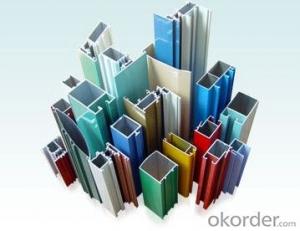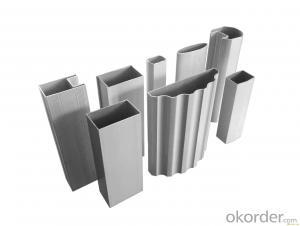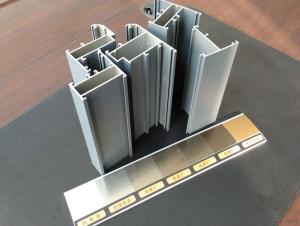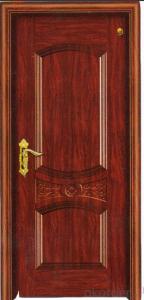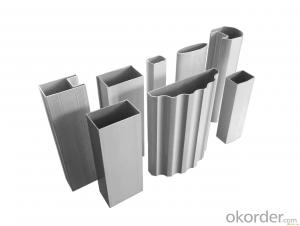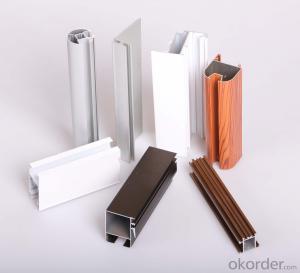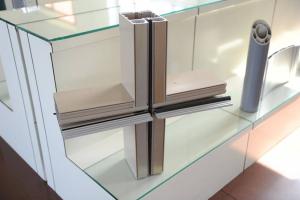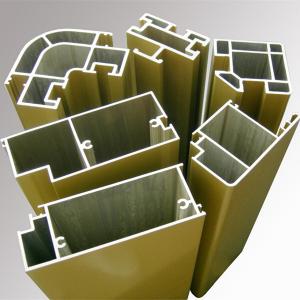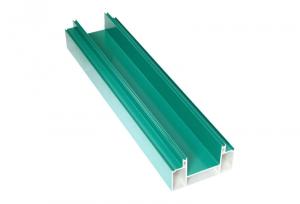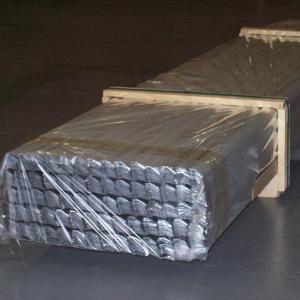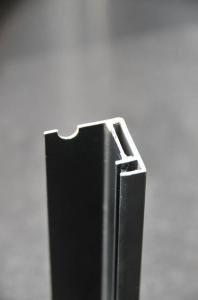Fath Aluminum Profiles for Doors and Windows
- Loading Port:
- China Main Port
- Payment Terms:
- TT OR LC
- Min Order Qty:
- -
- Supply Capability:
- -
OKorder Service Pledge
OKorder Financial Service
You Might Also Like
Name: Aluminium Profiles for doors and windows
1. Surface: Wood grain surface treatment
2. Alloy:6082T6 alloy temper
3. Size:various dimensions to meet customer’s requirement
4. Usage: Doors and windows are extensive made of aluminum profile due toplasticity and light weight. This product is used of high quality material with woodgrain surface treatment. It is a long life used and safety protection for home.Any size of products can be provided according to your requirement.
5. Package: Normal export packing with paper-plastics and can be packed according to customers requirement
6. Life Time: Last for 50 years
7. Standard: EN755-9 standard
Mill finish | Finish of aluminum itself,with a natural anodic layer formed in the air,week corrosion resistance. |
Anodizing | Through an eletrical process to f.orm a certain layer of anodic layer on the surface of profile,available in different colors,including silver,champagne,bronze,dark,golden,etc. |
Polishing | By buffing and chemical process to form mirror like finish,suitable for decorative application. |
Powder coating | The powdered paint is electrostatically charged and sprayed onto the part,to form a thick layer to protect the surface.with very good corrosion resistance. |
Wooden finish | New technology in finishing to form a texture look like real wood.Handtouch or film transfering are both available. |
Sliding DoorEletropharesis | Base on anodized process,an extra transparent film is formed to make the surface clearer and look bit of shining,with very good corrosion resistance. |
- Q: How do aluminum profiles contribute to energy-efficient lighting systems?
- Aluminum profiles contribute to energy-efficient lighting systems by providing a lightweight and durable framework for LED light fixtures. The high thermal conductivity of aluminum helps dissipate heat generated by the LED bulbs, ensuring proper cooling and longer lifespan. Additionally, the versatility of aluminum profiles allows for easy customization and integration of various components, such as lenses and reflectors, optimizing light distribution and reducing energy waste.
- Q: What are the advantages of using aluminum profiles in the mining industry?
- There are several advantages of using aluminum profiles in the mining industry. Firstly, aluminum profiles are lightweight yet strong, making them ideal for use in mining equipment. This allows for easier transportation and installation of mining machinery, resulting in increased efficiency and reduced costs. Secondly, aluminum profiles are highly resistant to corrosion. In the mining industry, where equipment is exposed to harsh environments and corrosive materials, this is a significant advantage. The durability of aluminum profiles ensures that mining equipment remains in good condition for longer periods, reducing maintenance and replacement costs. Additionally, aluminum profiles are non-magnetic, which is crucial in mining operations involving magnetic materials such as iron ore. This property prevents interference with sensitive mining equipment, ensuring accurate measurements and efficient operations. Moreover, aluminum profiles are highly versatile and can be easily customized to suit the specific needs of mining operations. They can be machined, welded, and formed into various shapes and sizes, allowing for the creation of tailor-made structures and equipment. This flexibility facilitates innovation and optimization in the mining industry. Furthermore, aluminum profiles have excellent thermal conductivity. In mining applications where temperature control is essential, such as in smelting or refining processes, this property is advantageous. Aluminum profiles can efficiently dissipate heat, preventing equipment from overheating and ensuring optimal performance. Lastly, aluminum profiles are highly sustainable. Aluminum is a widely recycled material, and using aluminum profiles in the mining industry promotes a circular economy and reduces environmental impact. The recyclability of aluminum profiles also offers cost savings in the long run. In conclusion, the advantages of using aluminum profiles in the mining industry include their lightweight yet strong nature, resistance to corrosion, non-magnetic properties, versatility, thermal conductivity, and sustainability. These benefits contribute to improved efficiency, reduced costs, and enhanced environmental performance in mining operations.
- Q: Are aluminum profiles resistant to impact or vibration?
- Yes, aluminum profiles are generally resistant to impact and vibration due to their high strength-to-weight ratio and excellent damping properties.
- Q: How do aluminum profiles perform in seismic or earthquake-prone areas?
- Aluminum profiles have shown to perform well in seismic or earthquake-prone areas due to their inherent properties. Aluminum is a lightweight and flexible material, which allows it to absorb and dissipate seismic energy effectively. This helps in reducing the impact of earthquakes on structures and minimizing damage. Additionally, aluminum profiles are highly resistant to corrosion, which is beneficial in areas with high seismic activity as it ensures the longevity and structural integrity of buildings.
- Q: Can aluminum profiles be used in construction?
- Yes, aluminum profiles can be used in construction. Aluminum is a lightweight yet strong material that is resistant to corrosion, making it suitable for various construction applications. It is commonly used in the construction industry for building facades, windows, doors, roofing systems, and structural components. Additionally, aluminum profiles offer flexibility in design, easy installation, and low maintenance requirements, making them a popular choice in construction projects.
- Q: What are the advantages of using aluminum profiles in the aviation industry?
- The aviation industry benefits from several advantages when utilizing aluminum profiles. To start with, the lightweight nature of aluminum is of utmost importance. In aviation, this characteristic plays a crucial role in reducing overall aircraft weight, ultimately leading to enhanced fuel efficiency. Manufacturers of aircraft can employ aluminum profiles to develop lighter structures without compromising on strength and durability. Furthermore, aluminum displays exceptional resistance to corrosion. This proves especially valuable in the aviation sector where aircraft are exposed to severe environmental conditions like high humidity, temperatures, and saltwater exposure. Aluminum profiles can withstand these conditions, effectively preventing corrosion and ensuring the long-lasting lifespan of the aircraft. In addition, aluminum profiles offer an impressive strength-to-weight ratio. This means they provide a sturdy and inflexible structure while remaining lightweight. This quality is essential for ensuring the structural integrity and safety of the aircraft. Aluminum profiles can endure the stresses and loads encountered during flight, thereby contributing to the overall safety of the aircraft. Moreover, aluminum is highly malleable, making it easy to shape and mold into intricate designs. This characteristic allows for greater design flexibility in aircraft manufacturing, enabling manufacturers to create aerodynamic and efficient structures. Aluminum profiles can be fabricated, welded, and joined with ease, providing convenience in manufacturing and assembly within the aviation industry. Lastly, aluminum is an incredibly recyclable material. With the growing emphasis on sustainability, utilizing aluminum profiles in aircraft construction helps reduce the carbon footprint. Aluminum can be recycled and reused multiple times without compromising its advantageous properties, making it an environmentally friendly choice. In conclusion, the utilization of aluminum profiles in the aviation industry offers numerous advantages, including lightweight construction, corrosion resistance, high strength-to-weight ratio, design flexibility, and recyclability. These properties position aluminum as an ideal material for aircraft manufacturing, contributing to improved fuel efficiency, safety, and sustainability.
- Q: How do aluminum profiles contribute to daylighting strategies?
- Aluminum profiles play a significant role in daylighting strategies by facilitating the efficient use of natural light in buildings. These profiles are used to create windows, skylights, and curtain wall systems, which allow for the maximum entry of sunlight into the interior spaces. One of the primary advantages of using aluminum profiles in daylighting strategies is their ability to support large glass panes. Aluminum is lightweight and structurally strong, enabling the creation of expansive glazing systems that maximize the transmission of natural light. These profiles can be designed to have slim sightlines, providing unobstructed views and allowing more sunlight to enter the building. Moreover, aluminum profiles can be thermally broken, meaning they have a layer of insulation between the interior and exterior aluminum sections. This thermal break prevents the transfer of heat and cold, improving the energy efficiency of the building. By minimizing thermal bridging, aluminum profiles contribute to reducing the loss of heat or cool air, resulting in lower energy consumption for heating and cooling systems. Additionally, aluminum profiles can be finished with various coatings that enhance their daylighting performance. For instance, reflective coatings can be applied to the profiles to redirect sunlight deeper into the interior, increasing the overall brightness of the space. Such coatings can also help reduce glare and control the intensity of sunlight, creating a more comfortable and visually pleasing environment. Furthermore, aluminum profiles offer flexibility in terms of design and customization. They can be shaped into different geometries and sizes, enabling architects to create innovative and unique daylighting solutions. For example, the profiles can be curved, angled, or combined with other materials to achieve specific aesthetic and functional requirements. In summary, aluminum profiles contribute to daylighting strategies by allowing for the efficient use of natural light in buildings. Through their structural strength, thermal performance, and customization possibilities, these profiles enable the creation of large glazing systems that maximize the entry of sunlight while maintaining energy efficiency and visual comfort.
- Q: Can aluminum profiles be used in modular exhibition system manufacturing?
- Yes, aluminum profiles can be used in modular exhibition system manufacturing. Aluminum profiles are lightweight, durable, and easy to work with, making them a popular choice for constructing modular exhibition systems. They can be easily customized and assembled to create various shapes and configurations, providing flexibility and versatility in exhibition designs. Additionally, aluminum profiles offer a sleek and professional appearance, enhancing the overall aesthetics of the exhibition system.
- Q: How are aluminum profiles insulated?
- Aluminum profiles can be insulated in several ways to enhance their thermal performance. One common method is to incorporate a thermal break within the profile design. This involves the insertion of a non-conductive material, such as polyamide or polyurethane, between the inner and outer parts of the profile. This thermal break helps to minimize heat transfer between the interior and exterior of a building, thus improving energy efficiency. Another approach to insulating aluminum profiles is through the application of insulating materials, such as foam or rubber, on the interior or exterior surfaces of the profile. These materials act as barriers to reduce heat transfer and provide additional insulation. Furthermore, aluminum profiles can also be fitted with insulating gaskets or seals. These gaskets are typically made of rubber or other insulating materials and are positioned between the profile and the glazing, creating a thermal barrier and preventing heat loss or gain. Overall, the insulation of aluminum profiles involves incorporating thermal breaks, applying insulating materials, or using gaskets to minimize heat transfer and improve the energy efficiency of buildings.
- Q: I have a disinfection cabinet to cut off a piece of aluminum to install the control board, how to cut? What tool to cut?
- The use of wire saw can be sawed, if you cannot use a wire saw, it can only be used to drill holes along the need the position of the drill hole, finally use a tool to trim it to the edge.
Send your message to us
Fath Aluminum Profiles for Doors and Windows
- Loading Port:
- China Main Port
- Payment Terms:
- TT OR LC
- Min Order Qty:
- -
- Supply Capability:
- -
OKorder Service Pledge
OKorder Financial Service
Similar products
Hot products
Hot Searches
Related keywords
